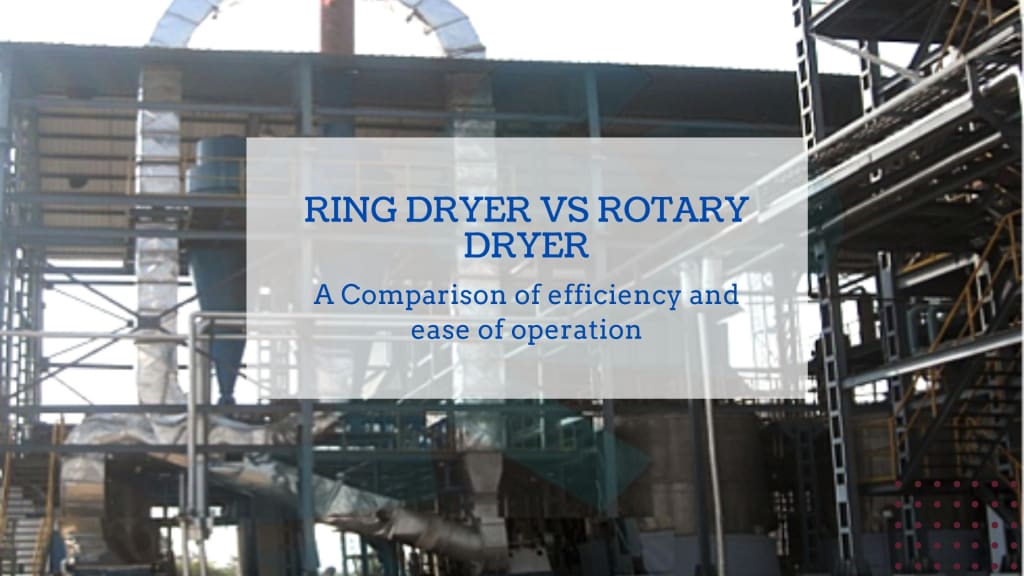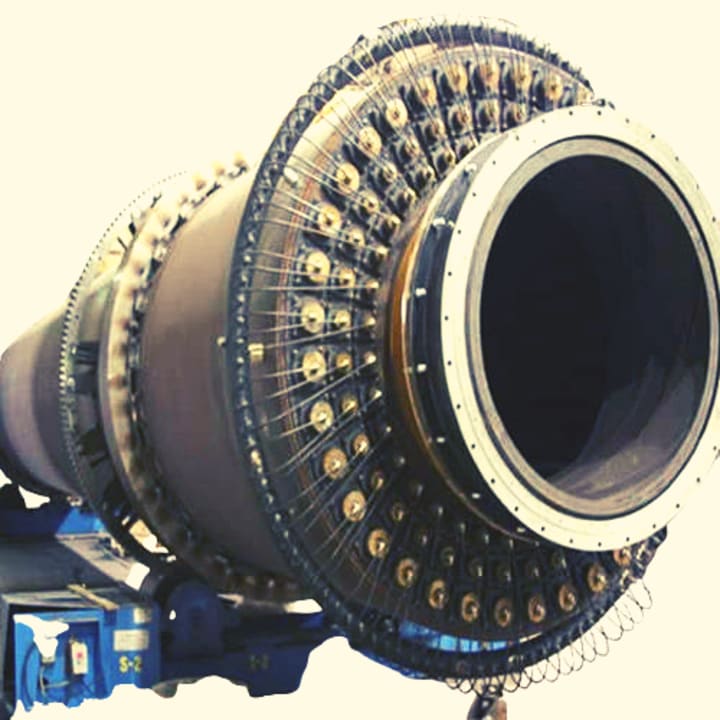Ring Dryer vs Rotary Dryer : A Comparison of efficiency and ease of operation for DDGS Drying Needs
Most large-scale industrial distillers grains drying is done on concurrent convective dryers where the wet material and heated drying gas pass together through the equipment.

Most large-scale industrial distillers grains drying is done on concurrent convective dryers where the wet material and heated drying gas pass together through the equipment. High inlet gas temperatures can be used without damaging the material because the surface moisture on the wet feed rapidly evaporates at the dryer inlet. This lowers the gas temperature and protects the surface of the particle.
Air is the most commonly used drying medium, but it has become common practice to recycle dryer exhaust gas to recover heat. In this case, the drying gas contains a lot of super heated water vapor and has reduced oxygen content. Pneumatic conveying (flash) dryers or rotary dryers are most commonly used.

Figure 1 shows a ring dryer system, a special type of flash dryer widely used in the grain processing industry to dry byproducts of corn starch wet milling and ethanol production. Typical processed materials are corn gluten meal, corn fiber, spent yeast and distillers dried grains with solubles (DDGS).
The material to be dried is often comprised of dewatered suspended solids concentrated in a centrifuge and mixed with wastewater that has been concentrated in an evaporator. These are mixed together and conditioned with recycled dry product from the dryer to form a friable, non-sticky material that can be fed into the dryer.
A high-speed throws the material in a finely divided stream into the hot drying medium at the feed venturi of the dryer. At this point, much of the moisture in the feed is flashed off due to the high velocity of the drying gas stream, which generates high heat and mass transfer.
The drying medium conveys the product to the manifold, a centrifugal classifier. The wetter, heavier particles are internally recycled back to the feed point to dry further, while the drier lighter particles pass out to be separated from the drying gas in a series of cyclonic separators. A portion of the dried product from the cyclones is recycled to the dryer mixing system to condition the incoming wet feed. The rest of the product passes to the product cooling system.
A ring dryer system has very little residence time. The material spends two seconds inside the dryer and around four minutes in the mixing and recycling system.

Figure 2 depicts a rotary dryer system. This type of dryer has been in use since the early 20th century, so it can be considered mature technology. Much of the peripheral equipment is identical to the ring dryer. Both systems have an air heater and use cyclones to separate the product from the drying air stream.
The drying drum is the heart of a rotary dryer, and the place where the drying gas and wet material are brought into contact. The material is showered through the air by rotating the drum. As the drum rotates, lifters mounted on the shell wall carry material up to the top, where it drops as a continuous curtain as the air passes through it.
The velocity through the drum is low, and the material usually stays in the drum between 10 and 20 minutes. Therefore, the major difference between a rotary and ring dryer is that the product is exposed to high temperatures for a longer time in the rotary dryer.
Recycled product is used to condition the feed in a rotary dryer, but the mixers are often much smaller than would be used for a ring dryer system because some of the feed conditioning can take place in the front end of the drum. However, this isn’t the best practice because poor mixing promotes agglomeration in the drum and leads to the formation of syrup balls.
Large rotary drums for this type of product weigh up to 100 tons and are supported on substantial tires and trunnions. The heavier the shell, tires and trunnions, the longer the drum will last and the longer the maintenance intervals. There is a significant difference between designs developed for the process industries and dryers used for agricultural service.
Operability and Quality Control
The major advantage of a rotary dryer is that it will continue to run despite an upstream process problem. Examples include excessive moisture, more flow than the dryer designed for or something in the wet feed that makes drying more difficult, such as high sugar content. With a rotary system, the inlet and outlet temperatures can be increased to cope with an increase in capacity. This comes at the expense of product quality, but the dryer will continue to run. The high residence time gives the rotary this tolerance, but it also means that recovery from a process upset is relatively long.
Compared with a rotary dryer, a ring dryer won’t tolerate as large a process swing because it keeps the material inside the dryer for two seconds, and in the mixing and recycling system for about four minutes.
On the other hand, ring dryers react faster to smaller process swings. When a ring dryer is operating, it’s making quality product that is superior to rotary-dried material. However, a well-run rotary dryer with a good mixing system can approach the quality of a ring dryer.
Footprint and Layout
A rotary dryer requires a large floor area and large concrete foundations to support the drum, trunnions and drive, as well as the main fan. It doesn’t require a lot of support steel.
A ring dryer has a much smaller footprint but needs a steel structure. However, the only piece of equipment that needs a substantial foundation is the main fan.
Neither type of dryer needs to be housed in a building. However, if a ring dryer is to be enclosed, then cladding can be put on the support steel. The steelwork merely has to be strengthened to take the force of the cladding wind load.
Material Handling and Recycling Systems
A rotary dryer deposits its product at one end while the feed is typically introduced 60 to 70 feet away at the other end. This means that the recycle conveyors are long.
A ring dryer has much shorter conveyors and uses gravity to help with the conveying.
Leakage and Impact on Energy Usage
A rotary dryer has two large diameter seals at either end, which are under suction. This gives rise to a large leakage rate, which causes an energy loss. Ring dryers have much smaller leakage rates because there are few leakage points. Consequently, rotary dryers use between 5 percent and 10 percent more heat than ring dryers, depending on the condition of their seals.
Electrical Usage
Rotary dryers use the rotation of the drum to convey the product, and ring dryers convey the product pneumatically at high velocity. Consequently, the main fan in a ring dryer has a higher pressure drop and consumes more power than a rotary dryer.
However, the extra cost of electrical power by the ring dryer is much less than the extra cost of heat by the rotary dryer.
Maintenance
Rotary dryers have many mechanical systems on the drum that require a significant amount of regular maintenance. If the dryer and/or its support tyres and trunnions are of a lighter design, then the maintenance requirement will be even higher. The extra conveyors also require more maintenance.
Ring dryers don’t have significant maintenance beyond the main fan. This means the total cost of ownership of a ring dryer is generally less than a rotary dryer.
This discussion should provide a good starting point for helping prospective ethanol plant owners gather the information needed to make an informed decision about drying distiller’s grains. It’s a major decision, affecting not only current capital costs, but the operating costs and profitability of the plant in the years ahead. It pays to carefully weigh all the factors.
About the Creator
MKS Industrial Solutions
An EPC based organization provides engineering services from feasibility studies to designing the world’s most advanced industrial engineering technologies to the global industrial market. https://www.mks.co.in/






Comments
There are no comments for this story
Be the first to respond and start the conversation.